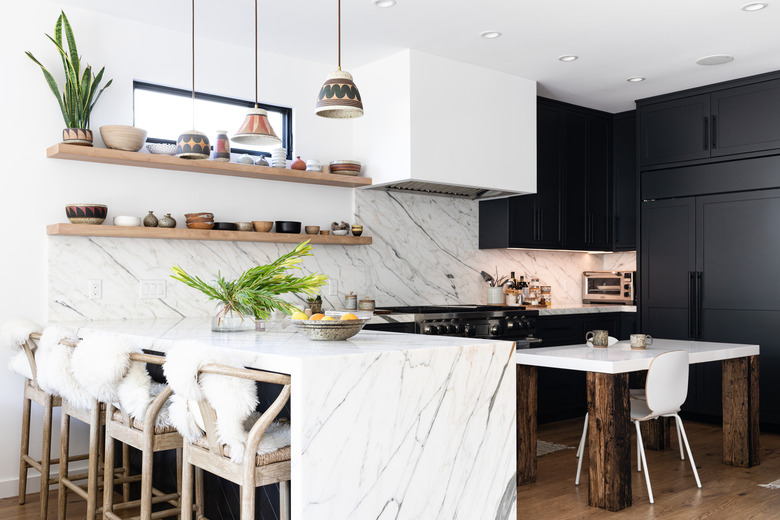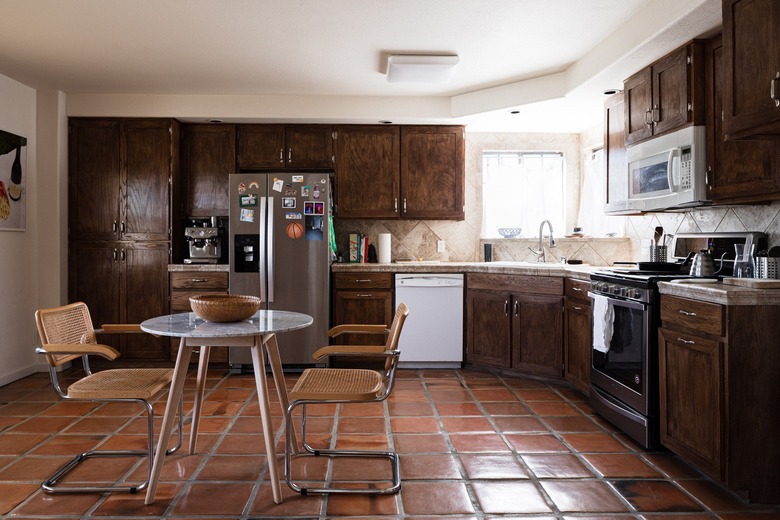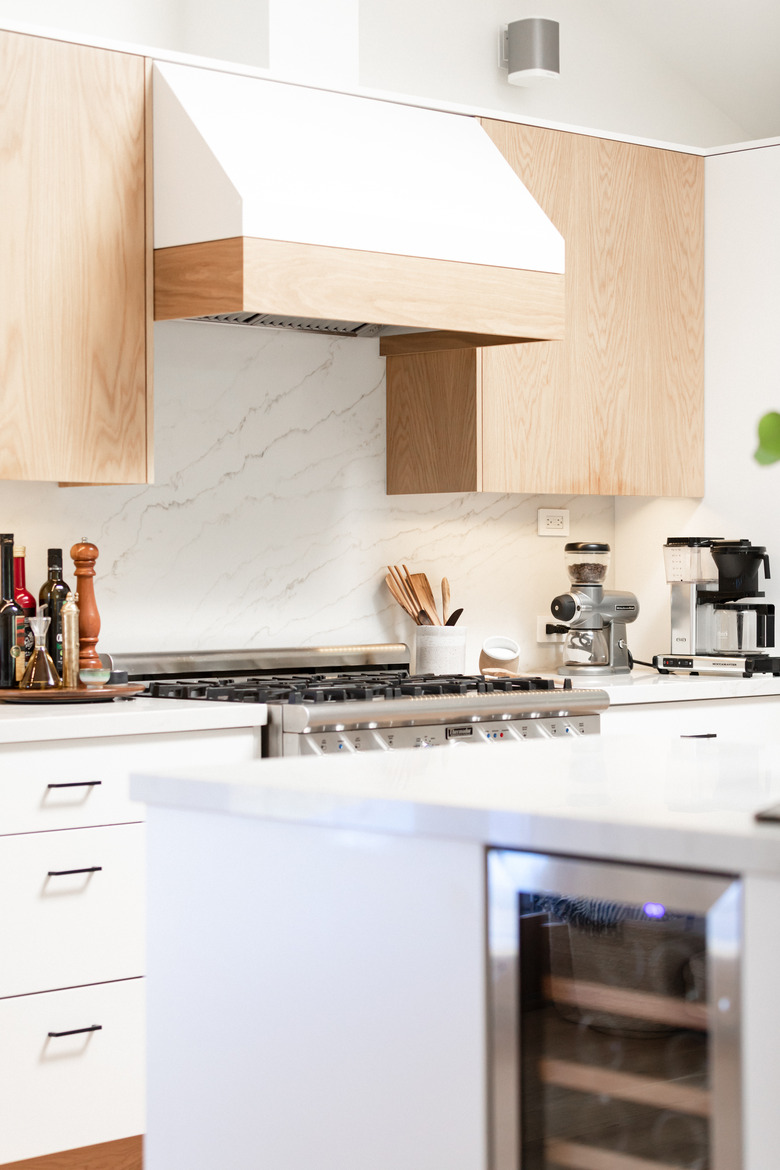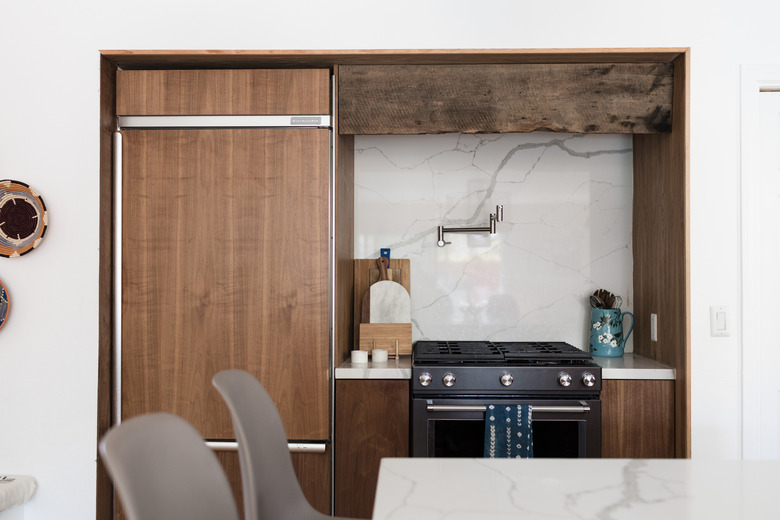Kitchen Stone Backsplashes: What You Should Know
A stone backsplash not only protects walls from the accidents that can happen during meal prep, but it also provides a design "wow" factor that other materials cannot. There is a variety of natural-stone products available in countless colors and patterns.
From a practical standpoint, most stone products are naturally heat-resistant and easy to keep clean — a plus for any kitchen material. However, some stone materials used in backsplashes, such as marble and granite, are luxury products that come with a luxury price tag. Fortunately, backsplashes in many types of stone can be created with individual tiles, which tend to be less expensive than large slabs. Tiles also provide a DIY option that can further reduce the cost of a stone backsplash.
Stone Backsplash Materials
Many types of natural stone can be used as a backsplash. They all have different looks and characteristics, and because they are natural materials, they tend to have some imperfections and variations that are perfectly normal.
- Granite may be the most popular countertop and backsplash material. It is extremely durable and is known for its wide variety of colors and patterns. The look varies from slab to slab with no two looking alike, even when they come from the same quarry.
- Marble has pronounced veining and sometimes bold colors, but subtler solid colors are also available. Acidic foods and liquids can etch the surface, leaving the finish dull-looking if the stone is not sealed.
- Soapstone, unlike granite or marble, comes in more solid colors that vary from off white to dark gray, although products with some marbling are available. It is usually maintained by applying a food-grade mineral oil.
- Slate can resist some stains, but oily liquids can cause damage. Slate surfaces are prone to scratches and other surface damage.
- Onyx comes in a number of colors and has distinctive veining that resembles marble. The resemblance is so close that in the past, onyx has been marketed as marble. It has low abrasion resistance, and it will acid etch when exposed to acidic foods.
- Quartzite is often confused with the engineered stone called quartz. Quartzite has subtle colors and veining. The material is considered difficult to work with, which could affect availability and lead time for jobs.
There are a number of finishes available for natural stone. Polished surfaces reflect light and help bring out the colors and patterns of the stone. Honed finishes provide a more matte-like appearance. Honed surfaces tend to help hide scratches and other minor damage better than polished surfaces.
Tiles Versus Slabs
Stone backsplashes can be made of individual stone tiles or monolithic stone slabs. A tile backsplash will have grout lines. A slab installation will not.
Tiles come in sizes similar to ceramic tiles, with 12-inch square and 24-inch square being the most popular. Because they are usually small spaces, backsplashes are a doable DIY project. You can find tiles made of most natural stone as well as mosaic tiles and river rock that are attached to a backing to form sheets. Tiles cost about $5 to $30 per square foot for the materials alone. Professional installation will cost about $25 to $35 per square foot.
A stone slab backsplash will average about $40 to $170 per square foot installed, but some materials and project conditions can drive the cost up to $240 per square foot. Both the quality of the stone and its availability affect its cost. For example, Carrara marble is the most common type specified (although there is less-expensive marble) and costs about $35 to $45 per square foot for the materials. Compare that with the hard-to-find Calacatta marble at $185 per square foot. It has uniform veining on extremely white backgrounds.
Backsplash-Design Considerations
In many kitchens, the backsplash becomes a focal point of the room, and a stone backsplash certainly contributes to the overall design of the space. Although they are both natural stone, tiles and slabs will provide two different looks. Tiles are thinner than slabs, and the grout lines are part of the overall look. Because grout comes in a variety of colors, you can create some distinctive designs. Slabs provide a clean, uninterrupted look.
Many people start with the countertop material when deciding on a backsplash. One option is to simply install the same material on the wall that is on the counter. That provides a classic, elegant look, especially when choosing marble or granite. However, a stone with lively veining and colors may be overwhelming when placed in both places.
If installing a slab backsplash that matches the counter, you have a choice between a 4-inch to 6-inch-high backsplash or a counter-to-ceiling or counter-to-cabinet installation that covers the entire wall. The benefit here is that the short backsplash can often come from the same slab as the countertop material. This reduces the cost somewhat and helps ensure that the veining and colors in the counter will continue uninterrupted on the backsplash.
Of course, there is no rule that says you must use the same material throughout the entire kitchen. One way to reduce cost is to use porcelain or glass tile in most areas and save the stone to achieve a luxury look in specific areas, such as around the range or cooktop or behind the sink. You can also choose to create an accent wall that is covered with natural stone.
Considerations for Ledger-Stone Backplashes
Many people like the look of ledger stone or ledgestone as a backsplash. These are tiles consisting of different-size stones bonded together. When installed, the effect is that of a wall of stacked, mortarless stones. It can be dramatic, but the irregular surface is extremely difficult to keep clean.
Even though the tiles will be sealed, grease and dirt can accumulate in the crevices. To help prevent that, clean the surfaces regularly and make sure the range hood is properly installed and in good working order. The Home Ventilating Institute has guidelines for range hoods.
Buying Stone Backsplashes
Stone tiles are available through home centers and tile-and-stone specialty retailers. Tile stores will provide the largest selection, including ledgerstone and river rock products. You can also receive good installation advice from these retailers, including picking the right-color grout for your project.
Backsplash slabs are available through countertop fabricators and home centers. Often, local fabricating companies work with larger retailers to do the actual fabrication and installation. Some retailers carry short lengths of 4-inch-high marble and granite backsplashes. They are usually marketed as backsplashes for vanities. The color selection is limited.
Natural stone is mined in large blocks that are then cut into slabs by specialized saws. The look of natural stone varies from slab to slab, even within the slab. So, when shopping, it is best to make a decision based on what the entire slab looks like. Often, shoppers are asked to pick a stone based on a small sample. It is difficult to get an idea of what the slab will look like in the kitchen based on a sample from a sample book.
Installing Stone Backsplashes
Natural stone tiles are installed as you would any wall tile. You can install the tiles directly to drywall, but the wall must be clean and flat. In most cases, the backsplash is installed after the counters have been put in place.
Old House Journal provides an overview of backsplash tiling, but be sure to check the manufacturer's directions. In some cases, only white grout should be used with some light-color stone. Darker grouts create a picture-frame effect around the tile. All stone tile and grout needs to be sealed, but some manufacturers recommend sealing the stone before grouting as well as after grouting to prevent the grout from staining the stone.
Because stone is a natural material with some variation, it is a good idea to do a dry layout of the tiles before installation. Usually, you can lay out the tiles on heavy cardboard placed on the countertop. That way, you can see how the veining and color changes move from tile to tile and make adjustments as necessary.
For slab backsplashes, the fabricator will take detailed measurements of the kitchen. He will cut the slabs to fit around cabinets and make cutouts for electrical outlets and switches on the wall. To get a clean, uninterrupted look, some people use plugmolds, which are receptacle strips that are installed under the wall cabinets where they are out of sight. You'll need an electrician to do the wiring, but you will get one continuous surface.
One of the reasons slab backsplashes are best left to the professionals is that stone slabs are heavy. Depending on the project, some slabs are attached to the wall with mastic or mechanical fasteners, such as wall anchors and ties designed for stone installations.
Stone Backsplash Maintenance
Because they are vertical surfaces, backsplashes are not subject to the same abuse as countertops, but some precautions are necessary to keep the stone looking new. Check with the manufacturer or fabricator, but most stone products must be sealed to help prevent staining. The term "seal" is used loosely because the products do not seal, but they make the stone surface stain-resistant. Sealers should be applied once or twice a year as per the manufacturer or fabricator.
For routine cleaning, wipe up any splatters or spills immediately. It is best to blot the spill and flush with water rather than spreading the mess around. Dry with a soft cloth. Do not use abrasive pads, scouring powders or harsh detergents because these can damage the surface of the stone. Consult the manufacturer or fabricator for recommended cleaning solutions.
The type of stone determines the type of cleaner recommended. Because of their composition, marble and onyx belong to a category of stone called "calcareous." This type is susceptible to acids, which can etch the surface of the material. Acid-free cleaners are recommended.
Siliceous stone such as granite, slate, soapstone and quartzite are not prone to acid etching in the same way as marble and onyx. These materials can be cleaned with cleaners that contain a small amount of acid, although many manufacturers shy away from suggesting the use of any type of acidic cleaner on stone surfaces. When in doubt, use a cleaner recommended by the stone dealer or fabricator.
Stains and Other Damage
The key to removing stains is to identify what caused the stain. Oil-based stains caused by grease, cooking oil or milk will darken the stone. The stain must be chemically dissolved before it can be flushed away with water. The Natural Stone Institute recommends using household detergent or mineral spirits to dissolve the stain.
Stains caused by organic substances like coffee, tea or wine leave a pinkish-brown stain. If initial cleaning does not remove the stain, try using 12 percent hydrogen peroxide (hair-bleaching strength) with a few drops of ammonia.
Minor scratches may be able to be buffed out with 0000 steel wool. If that does not work or if the scratches and nicks are very deep, call in a professional stone restorer. The restorer may be able to repair the damage and repolish the stone.
Acidic materials can etch some types of stone. Sometimes, the stone will have etch marks and a stain. Call a stone restorer to refinish or repolish the surface to fix the problem.



